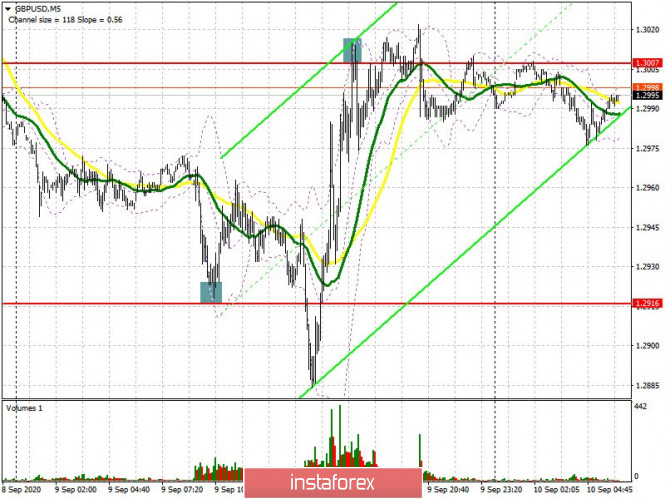
To open long positions on GBP/USD, you need:
Yesterday, it was not possible to catch the pound's main movements that occurred within the day, but in general, we managed to earn several dozen points on pullback movements after testing large support and resistance levels. Let's look at the deals. If you look at the 5-minute chart, you will see how buy positions for rebounding from the support of 1.2916 brought about 30 points, after which a false breakout of this level took place. However, it was not possible to wait for a convenient entry point from this range. After an upward correction in the afternoon, sell positions for a rebound from the resistance of 1.3007 on the first test also brought about 30 points of profit. At the moment, the bulls have the main task of breaking through and settling above the resistance of 1.3018, which coincides with yesterday's highs. This will lead to continuing the bullish correction and it is quite possible to return to the resistance area of 1.3103, which is where I recommend taking profits. We should not expect a strong bullish momentum, given the lack of important fundamental data on the British economy, and the current situation with the Brexit trade deal. It is best to open long positions in GBP/USD after a downward correction and a false breakout in the support area of 1.2940, where the lower limit of a new upward channel can also appear. I recommend making longs for a rebound from the week's low of 1.2890, but only based on a correction of 30-40 points from this level, since a repeated test of this range will certainly return large sellers to the market who are betting on the pair's decline in the long term.
Let me remind you that the Commitment of Traders (COT) reports for September 1 showed an increase in both long and short positions, but there were more buyers. Short non-commercial positions increased from 39,790 to 42,901 during the week. Non-commercial long positions grew from 39,045 to 49,213. As a result, the non-commercial net position also slightly grew and remained in positive territory, reaching 6,312, against 5,600.

To open short positions on GBP/USD, you need:
Sellers need to urgently protect resistance at 1.3018, a false breakout on it will cause GBP/USD to repeatedly fall to the support area of 1.2940, where the main struggle for the pair's long term direction will unfold. Consolidating below this range will open a straight road to the low of 1.2890, a breakout of which will quickly pull down the British pound to the 1.2840 area with the prospect of falling to the large support area of 1.2775, where I recommend taking profit. In case bears are not active in the 1.3018 area, it is best to postpone short positions until the resistance test at 1.3103 and sell GBP/USD from there immediately on a rebound, counting on a 30-40 pips correction within the day.

Indicator signals:
Moving averages
Trading is carried out in the area of 30 and 50 moving averages, which indicates the likelihood of a continuation of the upward correction.
Note: The period and prices of moving averages are considered by the author on the H1 hourly chart and differs from the general definition of the classic daily moving averages on the D1 daily chart.
Bollinger Bands
A breakout of the upper border of the indicator around 1.3025 will cause the GBP/USD to increase. A breakthrough of the lower limit around 1.2940 will increase pressure on the pound.
Description of indicators
Moving average (moving average, determines the current trend by smoothing out volatility and noise). Period 50. It is marked in yellow on the chart. Moving average (moving average, determines the current trend by smoothing out volatility and noise). Period 30. It is marked in green on the chart. MACD indicator (Moving Average Convergence/Divergence — convergence/divergence of moving averages) Quick EMA period 12. Slow EMA period to 26. SMA period 9 Bollinger Bands (Bollinger Bands). Period 20 Non-commercial speculative traders, such as individual traders, hedge funds, and large institutions that use the futures market for speculative purposes and meet certain requirements. Long non-commercial positions represent the total long open position of non-commercial traders. Short non-commercial positions represent the total short open position of non-commercial traders. Total non-commercial net position is the difference between short and long positions of non-commercial traders.